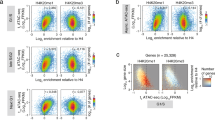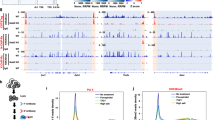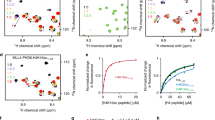Abstract
Eukaryotic genomes are organized into active (euchromatic) and inactive (heterochromatic) chromatin domains. Post-translational modifications of histones (or ‘marks’) are key in defining these functional states, particularly in promoter regions1,2. Mutual regulatory interactions between these marks—and the enzymes that catalyse them—contribute to the shaping of this epigenetic landscape, in a manner that remains to be fully elucidated1,2. We previously observed that asymmetric di-methylation of histone H3 arginine 2 (H3R2me2a) counter-correlates with di- and tri- methylation of H3 lysine 4 (H3K4me2, H3K4me3) on human promoters3. Here we show that the arginine methyltransferase PRMT6 catalyses H3R2 di-methylation in vitro and controls global levels of H3R2me2a in vivo. H3R2 methylation by PRMT6 was prevented by the presence of H3K4me3 on the H3 tail. Conversely, the H3R2me2a mark prevented methylation of H3K4 as well as binding to the H3 tail by an ASH2/WDR5/MLL-family methyltransferase complex4,5,6,7. Chromatin immunoprecipitation showed that H3R2me2a was distributed within the body and at the 3′ end of human genes, regardless of their transcriptional state, whereas it was selectively and locally depleted from active promoters, coincident with the presence of H3K4me3. Hence, the mutual antagonism between H3R2 and H3K4 methylation, together with the association of MLL-family complexes with the basal transcription machinery8, may contribute to the localized patterns of H3K4 tri-methylation characteristic of transcriptionally poised or active promoters in mammalian genomes1,2,3,9,10.
This is a preview of subscription content, access via your institution
Access options
Subscribe to this journal
Receive 51 print issues and online access
$199.00 per year
only $3.90 per issue
Buy this article
- Purchase on Springer Link
- Instant access to full article PDF
Prices may be subject to local taxes which are calculated during checkout




Similar content being viewed by others
References
Kouzarides, T. Chromatin modifications and their function. Cell 128, 693–705 (2007)
Li, B., Carey, M. & Workman, J. L. The role of chromatin during transcription. Cell 128, 707–719 (2007)
Guccione, E. et al. Myc-binding-site recognition in the human genome is determined by chromatin context. Nature Cell Biol. 8, 764–770 (2006)
Tenney, K. & Shilatifard, A. A. COMPASS in the voyage of defining the role of trithorax/MLL-containing complexes: linking leukemogensis to covalent modifications of chromatin. J. Cell. Biochem. 95, 429–436 (2005)
Wysocka, J., Myers, M. P., Laherty, C. D., Eisenman, R. N. & Herr, W. Human Sin3 deacetylase and trithorax-related Set1/Ash2 histone H3–K4 methyltransferase are tethered together selectively by the cell-proliferation factor HCF-1. Genes Dev. 17, 896–911 (2003)
Hughes, C. M. et al. Menin associates with a trithorax family histone methyltransferase complex and with the hoxc8 locus. Mol. Cell 13, 587–597 (2004)
Steward, M. M. et al. Molecular regulation of H3K4 trimethylation by ASH2L, a shared subunit of MLL complexes. Nature Struct. Mol. Biol. 13, 852–854 (2006)
Hampsey, M. & Reinberg, D. Tails of intrigue: phosphorylation of RNA polymerase II mediates histone methylation. Cell 113, 429–432 (2003)
Bernstein, B. E. et al. Genomic maps and comparative analysis of histone modifications in human and mouse. Cell 120, 169–181 (2005)
Kouskouti, A. & Talianidis, I. Histone modifications defining active genes persist after transcriptional and mitotic inactivation. EMBO J. 24, 347–357 (2005)
Bedford, M. T. & Richard, S. Arginine methylation: an emerging regulator of protein function. Mol. Cell 18, 263–272 (2005)
Krause, C. D. et al. Protein arginine methyltransferases: evolution and assessment of their pharmacological and therapeutic potential. Pharmacol. Ther. 113, 50–87 (2007)
Maurer-Stroh, S. et al. The Tudor domain 'Royal Family': Tudor, plant Agenet, Chromo, PWWP and MBT domains. Trends Biochem. Sci. 28, 69–74 (2003)
Sims, R. J. & Reinberg, D. Histone H3 Lys 4 methylation: caught in a bind? Genes Dev. 20, 2779–2786 (2006)
Strahl, B. D. et al. Methylation of histone H4 at arginine 3 occurs in vivo and is mediated by the nuclear receptor coactivator PRMT1. Curr. Biol. 11, 996–1000 (2001)
Huang, S., Litt, M. & Felsenfeld, G. Methylation of histone H4 by arginine methyltransferase PRMT1 is essential in vivo for many subsequent histone modifications. Genes Dev. 19, 1885–1893 (2005)
Daujat, S. et al. Crosstalk between CARM1 methylation and CBP acetylation on histone H3. Curr. Biol. 12, 2090–2097 (2002)
Bauer, U. M., Daujat, S., Nielsen, S. J., Nightingale, K. & Kouzarides, T. Methylation at arginine 17 of histone H3 is linked to gene activation. EMBO Rep. 3, 39–44 (2002)
Covic, M. et al. Arginine methyltransferase CARM1 is a promoter-specific regulator of NF-κB-dependent gene expression. EMBO J. 24, 85–96 (2005)
Schurter, B. T. et al. Methylation of histone H3 by coactivator-associated arginine methyltransferase 1. Biochemistry 40, 5747–5756 (2001)
Torres-Padilla, M. E., Parfitt, D. E., Kouzarides, T. & Zernicka-Goetz, M. Histone arginine methylation regulates pluripotency in the early mouse embryo. Nature 445, 214–218 (2007)
Wysocka, J. et al. WDR5 associates with histone H3 methylated at K4 and is essential for H3 K4 methylation and vertebrate development. Cell 121, 859–872 (2005)
Couture, J. F., Collazo, E. & Trievel, R. C. Molecular recognition of histone H3 by the WD40 protein WDR5. Nat. Struct. Mol. Biol. 13, 698–703 (2006)
Han, Z. et al. Structural basis for the specific recognition of methylated histone H3 lysine 4 by the WD-40 protein WDR5. Mol. Cell 22, 137–144 (2006)
Ruthenburg, A. J. et al. Histone H3 recognition and presentation by the WDR5 module of the MLL1 complex. Nature Struct. Mol. Biol. 13, 704–712 (2006)
Schuetz, A. et al. Structural basis for molecular recognition and presentation of histone H3 by WDR5. EMBO J. 25, 4245–4252 (2006)
Dou, Y. et al. Regulation of MLL1 H3K4 methyltransferase activity by its core components. Nature Struct. Mol. Biol. 13, 713–719 (2006)
Kirmizis, A. et al. Arginine methylation at histone H3R2 controls deposition of H3K4 trimethylation. Nature doi: 10.1038/nature06160 (this issue)
Frank, S. R., Schroeder, M., Fernandez, P., Taubert, S. & Amati, B. Binding of c-Myc to chromatin mediates mitogen-induced acetylation of histone H4 and gene activation. Genes Dev. 15, 2069–2082 (2001)
Pajic, A. et al. Cell cycle activation by c-myc in a burkitt lymphoma model cell line. Int. J. Cancer 87, 787–793 (2000)
Xie, B., Invernizzi, C. F., Richard, S. & Wainberg, M. A. Arginine methylation of the human immunodeficiency virus type 1 Tat protein by PRMT6 negatively affects Tat interactions with both cyclin T1 and the Tat transactivation region. J. Virol. 81, 4226–4234 (2007)
Pavri, R. et al. Histone H2B monoubiquitination functions cooperatively with FACT to regulate elongation by RNA polymerase II. Cell 125, 703–717 (2006)
Rigaut, G. et al. A generic protein purification method for protein complex characterization and proteome exploration. Nature Biotechnol. 17, 1030–1032 (1999)
Acknowledgements
We thank G. Natoli, G. I. Dellino and all the members of our group for discussions; T. Kouzarides for PRMT4/CARM1 expression vectors and for communicating unpublished data; S. Richard, M. Wainberg and C. Invernizzi for PRMT6 vectors; D. Reinberg and P. Trojer for the Flag–ASH2 vector; and P. G. Pelicci for continuous support. This work was supported by a fellowship from the Italian Federation for Cancer Research (FIRC) to E.G., by grants from the Italian Association for Cancer Research (AIRC) to B.A. and by a grant from the Deutsche Forschungsgemeinschaft (DFG) to B.L.
Author Contributions E.G. and B.A. conceived the work and designed the experiments. B.A. supervised the project and wrote the manuscript. E.G. and F.M. performed ChIP, E.G. and C.B. performed biochemical experiments, and F.C. constructed expression vectors. M.C. performed the statistical analysis of ChIP data. H.S. and B.L. purified the TAP–ASH2 complex.
Author information
Authors and Affiliations
Corresponding author
Ethics declarations
Competing interests
Reprints and permissions information is available at www.nature.com/reprints. The authors declare no competing financial interests.
Supplementary information
Supplementary Information
The file contains Supplementary Figures 1-6 with Legends and additional references. (PDF 4741 kb)
Supplementary Information
The file contains Supplementary Table 1 with genomic coordinates and primers used in this work. (XLS 146 kb)
Rights and permissions
About this article
Cite this article
Guccione, E., Bassi, C., Casadio, F. et al. Methylation of histone H3R2 by PRMT6 and H3K4 by an MLL complex are mutually exclusive. Nature 449, 933–937 (2007). https://doi.org/10.1038/nature06166
Received:
Accepted:
Published:
Issue Date:
DOI: https://doi.org/10.1038/nature06166
This article is cited by
-
PRMT6 methylation of STAT3 regulates tumor metastasis in breast cancer
Cell Death & Disease (2023)
-
A mycobacterial effector promotes ferroptosis-dependent pathogenicity and dissemination
Nature Communications (2023)
-
LSD1/PRMT6-targeting gene therapy to attenuate androgen receptor toxic gain-of-function ameliorates spinobulbar muscular atrophy phenotypes in flies and mice
Nature Communications (2023)
-
Post-translational modification: a strategic response to high temperature in plants
aBIOTECH (2022)
-
Trans-tail regulation-mediated suppression of cryptic transcription
Experimental & Molecular Medicine (2021)
Comments
By submitting a comment you agree to abide by our Terms and Community Guidelines. If you find something abusive or that does not comply with our terms or guidelines please flag it as inappropriate.



